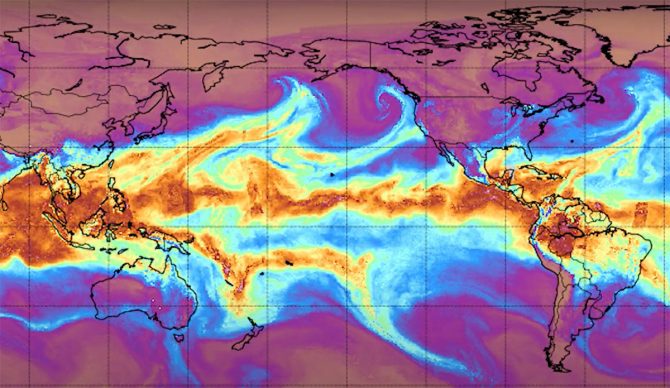
Atmospheric rivers are incredibly important to the Earth’s climate, but they’re changing. Photo: NASA//YouTube
According to a new study published in Science Advances, atmospheric rivers have been shifting towards the poles in the last few decades. That shift could have profound effects on global weather patterns.
Researchers at UC Santa Barbara studied the formation and movements of atmospheric rivers in both hemispheres over the last 40 years. They found that on average, they moved approximately six to 10 degrees closer to the poles. That means, of course, that the heavy rain and snowfall associated with them increases farther north and farther south than they have historically.
“Accelerating global warming in recent decades has contributed to a pronounced increase in the frequency and severity of extreme weather events globally, including heat waves, flash droughts, extreme precipitation, floods, and winter storms,” the study’s authors wrote. “More occurrences of such extremes regulate the hydrological cycle and result in an intensification of hydroclimate extremes and agricultural and ecosystem disasters. These changes pose diverse threats to human society and call for a closer examination of the underlying mechanisms driving these shifts in extreme precipitation and hydroclimatic patterns.”
Atmospheric rivers, for those unacquainted, are basically enormous rivers of moisture in the sky. On average, they move about the same amount of water vapor as the mouth of the great Mississippi River. One of the more famous ones is the “Pineapple Express,” that moves water vapor from Hawaii to the west coast of North America. The warm, moist air hits the coast and cools down as it rises, then dumps its vast amounts of water on parts of California, Oregon, Washington, and British Columbia.
Atmospheric rivers are important parts of climate. By some estimates, they’re responsible for around half of all the rain and snow that falls on the West Coast of the United States. The research hints that the years ahead might look far different, given the radical shift towards the poles.
“Regions that used to rely on atmospheric rivers for their precipitation could face increased droughts and heatwaves,” IFLScience wrote, “while regions in higher latitudes are likely to see heavier rainfall, stronger storms, and an increased risk of floods. For a region like southern California, the northward movement of atmospheric rivers could reduce rainfall even further, leading to more problems with water scarcity, droughts, and wildfires. Meanwhile, regions like the Pacific Northwest might see even wetter weather, unleashing issues like flooding.”
Like much of science, though, it’s still not entirely clear just how much the approaching new normal will affect the current normal. But it is clear that things will change, and likely drastically. The researchers are calling for more studies in hopes of preparing ourselves for what’s to come.
“Considering the prominent shifts of atmospheric rivers over the extratropical ocean,” they wrote, “how the ocean responds to these AR-induced changes requires further attention.”

